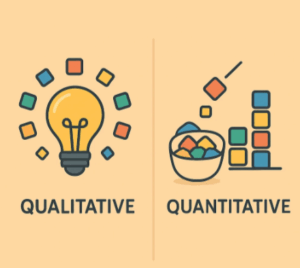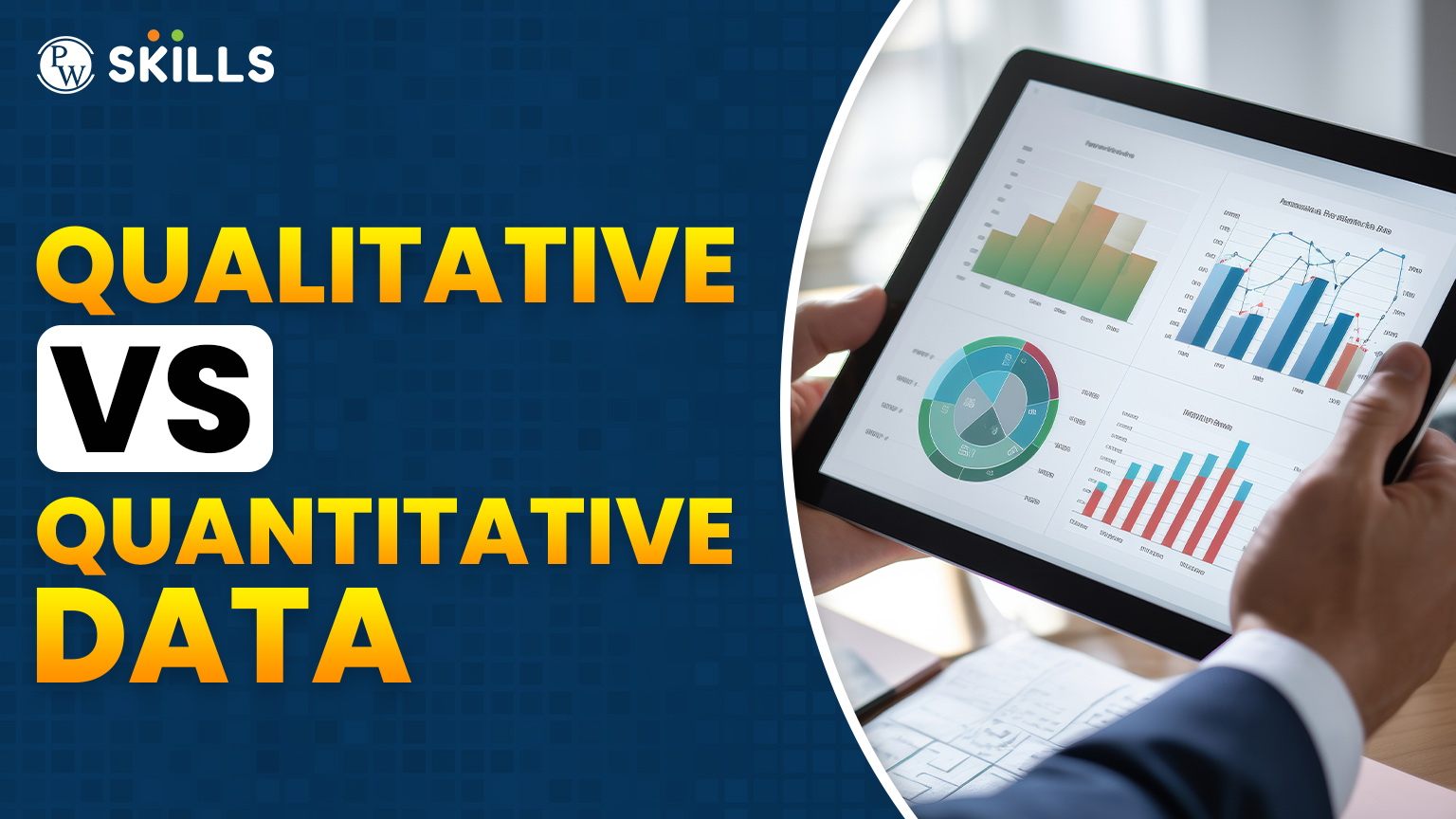The very first question that a budding researcher begins with is Qualitative vs Quantitative Data: What is that? Students often ask, “What is qualitative data?” What is quantitative data? How do they differ? These are two kinds of data upon which every research project stands, be it academic or business analytics.
In this guide, we will break down qualitative vs quantitative data in simple language, supported with examples, pros and cons, methods, and a table. For students doing their thesis or professionals making informed data decisions, understanding these concepts is imperative.
What is Quantitative Data?
Quantitative data means numbers as information. It is also quantifiable, countable, and subject to possible quantitative analysis.
- Exam marks: 85 out of 100
- Monthly salary: ₹50,000
- Company revenue: $1.2 million
- Number of students: 200
This data answers how much or how many and basically gives scientific proof to hypotheses.
What is Qualitative Data?
Qualitative data are non-numeric descriptions. Qualitative data indicate qualities, opinions, emotions, and reasons that lead to behaviors.
- The student says, “Online classes save time.”
- Customer feedback: “It’s a nice product design.”
- Employee Statement: “I feel that the work culture is inclusive.”
This data answers “Why?” and “How?” on the scale by numbers.
What Are the Differences Between Qualitative vs Quantitative Data?
The greatest difference between qualitative vs quantitative data is their nature and purpose.
- Quantitative = Numbers, measurable, statistical validation.
- Qualitative = Words, opinions, context, and emotions.
Both are necessary in research; at least quantitative tells the trend, and qualitative explains the reason.

Key Differences Between Qualitative vs Quantitative Data
| Factor | Quantitative Data | Qualitative Data |
| Nature | Numerical | Descriptive |
| Objective | Measures “how much” or “how many” | Explains “why” or “how” |
| Example | 70% of customers are satisfied | Customers are satisfied due to fast service |
| Analysis | Statistical tools | Thematic interpretation |
| Outcome | Trends, patterns | Insights, reasons |
Examples of Qualitative vs Quantitative Data
Quantitative Data examples: Height of students, number of app downloads daily, number of calories consumed, incorporation of a city in terms of population, number of working hours.
Qualitative Data Examples: Stressful online exams, reasons for preferring a certain brand over the other, emotions experienced in interviews, and themes in focus groups.
Advantages and Disadvantages of Quantitative Data
| Advantages of Quantitative Data | Disadvantages of Quantitative Data |
| Provides measurable and reliable proof for research findings. | Lacks context and does not explain the “why” behind numbers. |
| Easy to analyze using statistical tools and software. | Surveys and experiments can be rigid, missing important insights. |
| Can be scaled to cover large populations quickly. | May oversimplify complex human behaviors. |
| Enables comparisons, trends, and forecasting with precision. | Results may become biased if questions are poorly designed. |
| Helps in evidence-based decision-making for businesses and researchers. | Does not capture emotions, opinions, or deeper human experiences. |
![]() Join Our Data Analytics Telegram Channel
Join Our Data Analytics Telegram Channel
![]() Join Our Data Analytics WhatsApp Channel
Join Our Data Analytics WhatsApp Channel
Quantitative and Qualitative Research
What is quantitative research?
Quantitative research consists of quantitative data to respond to numerical questions. It involves organized surveys, experiments, and tests of statistics. For example, a researcher could query 1,000 students concerning how many of them want to study online.
What is qualitative research?
This research, while qualitative, is concerned with exploring experiences, perceptions, and opinions. Descriptive data comes mostly from interviews, focus groups, and observations. While quantitative research asks how many students prefer online learning, qualitative research questions why they prefer it.
Combining the Two
Most researchers will thus apply a mixed-methods approach, which is known in testing as qualitative vs quantitative data. Numbers highlight the trend, while words provide the explanation. In this balance, more accurate and actionable insights can be devised. Quantitative Data Collection Methods
Surveys and Questionnaires
The most common form of collecting quantitative data is through surveys asking for close-ended questions. This enables the researcher to collect quantitative data from a large audience within the shortest possible time.
Experiments and Trials
Experiments are measurements under controlled conditions. An example can be testing two versions of product versions and tracking the rates of purchase to bring about quantitative results for a company.
Official and Secondary Sources
Various governments, universities, and businesses publish reports containing useful quantitative data. Such reports include census records, financial statements, and measures of app use.
Qualitative Data Collection Methods
Interviews
One-on-one interviews provide amazing insights into someone’s individual experience. The method is able to capture emotions and opinions in ways that numbers literally cannot.
Focus Groups
Focus groups allow one to study a company’s group responses over a topic. For instance, a company may ask a group of customers to share opinions on a new product.
Observations and Case Studies
Observation sees how people are left to behave naturally in their lives; case studies get into real-life situations, but both are great examples of primary qualitative data collection methods that ask “why” things happen.
Balance of Numbers and Narratives
Both qualitative and quantitative data are essential for operational purposes. Quantitative depicts the patterns with a percent representation, whereas qualitative concludes the reasons for it.
Example of Combined Use
A school survey can state the following:70% of the students prefer online learning, which is quantitative. Subsequent interviews could show that the main reason is reduced stress from traveling (qualitative).
Stronger Decision-Making
The research is more reliable and rigorous with these two together. Numbers tell you what is happening, while stories tell you in which direction it matters.
Also Read:
- 4 Types of Data Analytics to Improve Decision-Making
- What is Data Lineage?: Best Tools, Simple Definition & Career Use Cases (2025 Insights)
- Unstructured Data: 5 Important Characteristics You Shouldn’t Ignore
- What Is Data Exchange? Complete Explanation For Beginners
Learn Data Analytics with PW Skills
What is great with the PW Skills Data Analytics Course is that it transcends just covering qualitative vs quantitative data; it is all about application, transforming every student into a data professional with practical training, real-time projects, and industry-ready skills. PW Skills covers it all from numbers to narratives. Enroll today and take the first step to your analytics career.
Yes, mixed-method research uses both to balance statistics with deeper insights. Quantitative is faster because surveys and numerical records are quicker to analyze. To understand customer emotion and preference and the motivations behind choices. Using both types together, qualitative and quantitative, ultimately leads to richer, more reliable decisions.Qualitative vs Quantitative Data FAQs
Can qualitative and quantitative data be combined in research?
Which is faster in collection: qualitative or quantitative data?
Why do businesses need qualitative data?
Which data system is best for decision-making?

